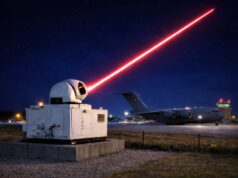RAF pilots have now flown more than 2800 missions in Iraq and Syria against Islamic State, striking 865 times in Iraq and over 50 times in Syria.
Defence Secretary Michael Fallon has also praised the decisive difference made by the RAF in the liberation of Fallujah. Speaking at the Royal United Service Institute’s (RUSI) annual airpower conference in London, Mr Fallon said the RAF had not operated at such a sustained operational tempo in a single conflict for a quarter of a century.
Defence Secretary Michael Fallon said:
“The RAF has not operated at this sustained operational tempo in a single theatre of conflict for a quarter of a century.
Our tempo and commitment to the operation – our precision targeting, our Intelligence, Surveillance, Reconnaissance, and our overall support to the coalition – shows no sign of abating.
Our aircraft played a key role in the liberation of Fallujah. I pay tribute to the outstanding work of all RAF personnel involved.”
The following recent strikes have taken place:
Thursday 7 July – Typhoons struck extremists in western Iraq, while Tornados and a Reaper attacked terrorists near Sharqat and Mosul in the north.
Friday 8 July – Typhoons provided support to Iraqi forces in close combat along the Euphrates valley. A Reaper also supported troops near Sharqat.
Saturday 9 July – A Reaper destroyed a truck in northern Iraq.
Sunday 10 July – Tornados hit seven targets in western and northern Iraq.
The details surrounding recent strikes have been released by the MoD:
In the early hours of Thursday 7 July, an RAF Reaper assisted Iraqi ground forces operating near Sharqat in the north of the country. The Reaper’s crew conducted two successful precision attacks using Hellfire missiles against two small groups of Daesh extremists firing on the Iraqi troops from a fortified position. Having located a larger group of terrorists, the Reaper then provided targeting assistance to an attack by coalition fast jets.
In northern Iraq, Tornado GR4s dropped a Paveway IV guided bomb which destroyed a heavy position 15 miles east of Mosul. Typhoon FGR4s meanwhile patrolled to the north of Ramadi and used a Paveway IV against a group of Daesh fighters concealed in a tree line.
Friday 8 July saw a Reaper again supporting operations around Sharqat. It conducted four attacks, with three Hellfires and one GBU-12 guided bomb, against several groups of terrorists manoeuvring in a gully, and an ammunition truck which was being loaded with rocket-propelled grenades. Over Anbar province, Typhoons maintained their patrols along the Euphrates north and west of Ramadi and supported an Iraqi unit engaged in very close combat with three Daesh heavy machine-gun and rocket-propelled grenade teams. Despite the proximity of the Iraqi troops, the three positions were successfully struck with Paveway IVs.
A Reaper employed a Hellfire on Saturday 9 July to destroy a truck carrying a Daesh group north of Bayji.
On Sunday 10 July, Tornados conducted an armed reconnaissance mission in the Mosul area. North-west of the city, they used Paveway IVs to attack a command and control post, a mortar team, and a weapons cache, then used a Brimstone missile to destroy a second weapons stockpile. A second Tornado flight operated over Anbar province conducted four attacks with Brimstone missiles to destroy a group of engineering vehicles, which Daesh had mustered to construct positions 35 miles south-west of Ramadi.














Freedom will never have a price. Keep up to good work lads!